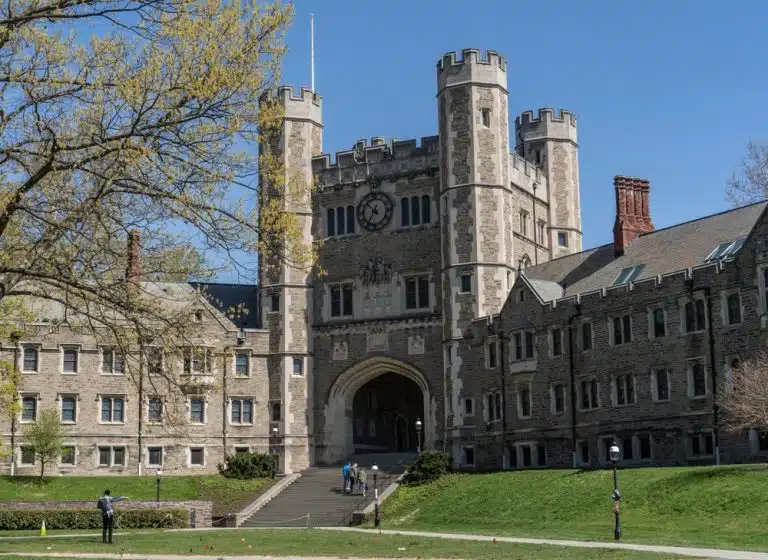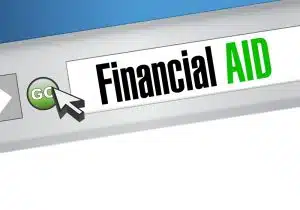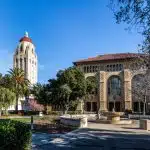Real talk: If Ivy League schools didn’t come with sky-high price tags, we’d all be lining up to get in. Prestige, world-class education, a golden ticket to endless opportunities—it’s the ultimate dream, right? But let’s face it, most of us aren’t exactly swimming in trust funds.
So, if you’re determined to snag that Ivy League badge while keeping your bank account intact, you’re probably asking: which one is the cheapest Ivy League school? Don’t worry, we’ve crunched the numbers and gathered all the details here to help you make an informed, budget-friendly decision.
- What Is the Cheapest Ivy League School?
- Cost Breakdown of Ivy League Schools
- How Much Is the Ivy League Application Fee?
- How to Pay for an Ivy League School
- Hidden Costs of Attending an Ivy League School
- Frequently Asked Questions
- Takeaways
What Is the Cheapest Ivy League School?
The cheapest Ivy League school is typically Princeton University. Princeton’s financial aid program is recognized as one of the most generous in the country, making it far more affordable for low- and middle-income families.
While the sticker price for tuition, fees, and living expenses at Ivy League schools is high, Princeton stands out because a significant 89% of recent seniors graduated debt-free, thanks to the school’s need-based aid packages.
For the 2024–2025 academic year, Princeton’s tuition, housing, and food costs total $82,650, but the estimated average grant for an aid student is around $72,000. This means the average net cost for aid recipients is just $10,650. Princeton meets 100% of demonstrated financial need with grant aid, often making it cheaper than your local state college or university.
If your family makes less than $100,000 a year, Princeton’s financial aid could cover the whole thing—tuition, room, board, you name it. Even families earning up to $300,000 a year get a break with lower expected contributions, as 65% of all students at Princeton qualify for financial aid.
Princeton is also one of the few universities that applies the same financial aid policy to international students to make sure they also get full need-based aid. Plus, Princeton doesn’t do loans, so you’re not leaving with a mountain of debt. Everything in their aid package is in grants, meaning it’s free money that doesn’t need to be paid back.
So, while the sticker price may be high, Princeton’s financial aid program really helps make it affordable for a wide range of families. This commitment to affordability cements its reputation as the cheapest Ivy League school year after year.
Cost Breakdown of Ivy League Schools
While Princeton is often considered the cheapest Ivy League school, it’s important to note that the actual costs will depend on your financial situation.
| School | Tuition | Housing | Food | Total estimated cost |
| Princeton University | $62,400 | $12,450 | $8,720 | $82,650 |
| Harvard University | $56,550 | $12,922 | $8,268 | $82,866 |
| Yale University | $67,250 | $11,300 | $8,600 | $87,150 |
| Columbia University | $68,000 | $17,580 | N/A | $92,742 |
| University of Pennsylvania | $60,920 | $12,640 | $6,534 | $92,288 |
| Dartmouth College | $66,123 | $12,018 | $7,731 | $90,813 |
| Brown University | $68,612 | $9,940 | $7,504 | $91,676 |
| Cornell University | $68,380 | $12,296 | $7,132 | $92,150 |
While Princeton is considered the cheapest Ivy League school, these costs can vary depending on your financial situation and eligibility for scholarships.
How Much Is the Ivy League Application Fee?
Applying to an Ivy League school comes with its own costs, starting with the application fee, which varies by school. Here’s the breakdown for each Ivy League application fee:
- Harvard University: $85
- University of Pennsylvania: $75
- Princeton University: $75
- Yale University: $80
- Cornell University: $80
- Brown University: $75
- Columbia University: $85
- Dartmouth College: $85
If you’re applying to multiple Ivies, these fees can really add up. Submitting applications to four schools, for example, would cost you $335 at most in just application fees. That’s quite a lot.
But don’t fret just yet. If paying for applications is tough, you might qualify for a fee waiver. Many Ivy League schools offer waivers if you demonstrate financial need. You can request one through the Common App, Coalition App, or directly through the school’s admissions office, so you don’t have to let fees hold you back.
How to Pay for an Ivy League School
Getting accepted to an Ivy League school is a huge win, but then the reality sets in: how do you actually pay for it? Luckily, there are ways to make it work, even if it’s not the cheapest Ivy League school. Here are some ways to help cover those costs:
1. Financial aid
The Ivy Leagues are serious about financial aid. They all offer need-based aid instead of merit-based, so it’s all about what your family can actually afford.
Take Princeton, for example: if your family makes under $100,000 a year, they’ll usually cover the whole thing—tuition, room, board, the works. Even if your family makes up to $300,000, Princeton might still cut you a good deal.
Harvard is similar. For families earning under $85,000, Harvard covers everything and you’ll pay nothing. The average financial aid package at Harvard? Around $70,525 a year, which makes even the cheapest Ivy League school look competitive.
2. Federal and state grants
On top of the aid from the school, you might be eligible for federal grants like the Pell Grant, which offers up to $7,395 a year if you’re from a low-income family. It won’t cover everything, but it definitely helps.
And if you’re from a state that offers its own grants, that’s even better. For example, if you’re a New York resident attending Columbia or Cornell, you could qualify for the New York State Tuition Assistance Program (TAP), which can range from $1,000 to $5,665 per year.
Ivy League schools usually add these grants right into your financial aid package, so you don’t have to worry about extra paperwork. Even with grants, families often turn to schools like Princeton, the cheapest Ivy League school, to minimize costs further.
3. Work-study programs
Ivy League schools have tons of on-campus jobs that allow you to earn money while you study. It won’t pay all your bills, but it’s great for covering personal expenses. Yale, for example, expects students who receive aid to contribute around $3,700 a year from their own earnings, which is totally doable with work-study jobs on campus.
You could be working as a library assistant or in a research lab, making some cash and getting experience at the same time. If you’re attending the cheapest Ivy League school, work-study earnings can often go even further due to lower net costs.
4. Student loans
While Ivy Leagues try to avoid loans in their aid packages, sometimes you still need to borrow. The good news is, many Ivy League schools have no-loan policies for families under a certain income level, meaning they replace loans with grants.
For instance, Columbia has a no-loan policy for families earning less than $150,000. Above that threshold, you might still need a small loan, but it’s usually a lot less than what you’d borrow at other schools. The Federal Direct Loan interest rate is around 5.5%, so if you do need to take out a loan, it’s manageable.
5. Outside scholarships
Scholarships from private organizations can help cover any gaps. Sites like Fastweb and Scholarships.com are packed with opportunities. For example, The Coca-Cola Scholars Program gives $20,000 to 150 students each year, and the Gates Scholarship covers everything for Pell-eligible students.
So, say you get into Princeton with a total cost of around $86,700. If your family makes under $100,000, Princeton might cover all of it, leaving you with zero out-of-pocket costs. If your family makes around $150,000, you could be looking at around $15,000 to $20,000. You could use a combination of federal grants, work-study, and maybe a small loan or outside scholarship to cover the rest.
With these options, attending an Ivy, even if it’s not the absolute cheapest Ivy League school, can actually be within reach. Take advantage of everything from school aid to federal grants, work-study, and outside scholarships, and you’ll find that the Ivy dream is a lot more achievable than you’d think.
Hidden Costs of Attending an Ivy League School
Getting into an Ivy League school is incredible, but even with financial aid, there are hidden costs that sneak up on you once you’re actually there. From travel expenses to winter gear, these extra costs can add up fast. Let’s break down what you might not see on the official bill, even if you’re attending the cheapest Ivy League school:
Travel expenses
First up: getting to and from campus. Ivy League schools are mostly in the Northeast, so if you’re from far away, those travel costs can get pricey.
Let’s say you’re from California and you’re headed to Harvard—a round-trip flight to Boston can run you anywhere from $300 to $600 depending on the season. And if you’re hoping to visit home a couple of times a year, that’s a serious hit to the wallet, even if you’re at the cheapest Ivy League school.
It’s even more expensive if you’re coming from overseas. A flight from, say, London to Columbia University in New York City could cost around $800 to $1,500 depending on the time of year. Some schools offer a little travel stipend if you’re on financial aid, but most don’t, so it’s smart to budget for a few trips.
Living costs in expensive cities
A lot of Ivy League schools are in cities with pretty high living costs. Take Columbia in New York City—rent’s covered if you’re on campus, but other stuff can really add up. In fact, living costs in New York City are significantly higher than in other Ivy League towns.
For example, rent prices in New York are 107.6% higher than in Hanover, New Hampshire, where Dartmouth College is located. Restaurant prices in NYC are also 73.9% higher than in Hanover, and groceries are 42% higher.
Even students at the cheapest Ivy League school face similar challenges if they need to travel for internships or buy essentials in nearby cities. If you’re at a more expensive Ivy like Columbia, expect everything from food to basic necessities to cost much more than it would.
Here’s what a typical month might look like in NYC:
- Groceries: $300 – $500 (yes, really)
- Public transit (subway): $132 for a monthly pass
- Going out to eat: Eating at an inexpensive restaurant will still cost you $30 per meal, and it only goes way up if you’re hitting a nice spot.
- Entertainment: $100+ if you’re seeing a movie, going to a museum, or grabbing drinks with friends
Textbooks and supplies
Textbooks are no joke, especially at the Ivy League level. Depending on your classes, you might spend anywhere from $500 to $1,200 per semester on books. If you’re taking something like pre-med or law, those giant textbooks can easily go for $200 to $300 each.
Even at the cheapest Ivy League school, these costs can pile up quickly. A lot of students try to save by buying used books, renting, or grabbing e-books if available. Schools also have textbook exchange programs and some textbooks on reserve in the library, but let’s be real—this is still a cost you need to plan for.
Everyday expenses
Living on your own means paying for all those little things you didn’t think about before. We’re talking laundry, toiletries, school supplies, and other essentials. Here’s a rough idea of what you might spend each month:
- Laundry: $10 – $20 a month (most schools charge per load, like $1.50 for washing and another $1.50 to dry)
- Toiletries: $20 – $30 (think shampoo, soap, toothpaste, etc.)
- School supplies: $10 – $30 (especially if you need specific stuff for certain classes)
And don’t forget things like gym memberships or nights out with friends! Even at the cheapest Ivy League school, these small costs add up over time. If you’re at Dartmouth in a small town, you’ll spend less on entertainment than a student at Columbia, but all these little costs still add up.
Winter gear
If you’re not from the Northeast, get ready for some serious winter weather. You’ll need a good winter coat, snow boots, gloves, and scarves—and none of this is cheap. A decent winter coat can cost $100 to $300, snow boots around $50 to $150, and then you’ve got hats, gloves, scarves, and all those layers.
For students coming from warmer climates, this can be an unexpected expense. And if you’re at a place like Cornell in upstate New York, you’re looking at months of snow and freezing temps, so skimping on winter gear isn’t an option.
Health insurance
Most Ivy League schools require students to have health insurance, and if you don’t have a family plan, you’ll need to get it through the school. Health insurance can cost anywhere from $2,000 to $4,000 a year, depending on the plan.
For example, Harvard’s Student Health Insurance Plan costs around $4,040 for the academic year. If you’re already covered, you can usually waive the fee, but for a lot of students, even those at the cheapest Ivy League school, this is just another big bill to factor in.
All of these hidden costs can make Ivy League tuition look like just the start of the bill. If you budget for these extra expenses, you’ll be way less stressed when they start popping up. Planning ahead means you can actually enjoy the Ivy League experience instead of worrying about surprise bills every month.
Frequently Asked Questions
1. Which Ivy League school is considered the cheapest?
The cheapest Ivy League school is Princeton University. With its generous financial aid, families earning under $100,000 often pay nothing. Even for families making up to $300,000, Princeton offers aid. The full cost is $82,650, but students on financial aid typically pay just $10,650.
2. How much is the application fee for Ivy League schools?
The Ivy League application fee varies by school, ranging from $75 to $85. Princeton, Brown, and the University of Pennsylvania each charge $75, while Columbia, Dartmouth, and Harvard charge $85. Yale and Cornell fall in the middle at $80 each. If needed, you can request a fee waiver through the Common App or the school’s admissions office.
3. How much do Ivy League schools cost?
Ivy League schools cost between $82,000 and $92,000 a year, including tuition, housing, and meals. For example, Princeton costs $82,650, and Columbia is $92,742. Financial aid often reduces these costs significantly, with many students paying far less.
4. How do I pay for an Ivy League school if my family earns $50,000 a year?
If your family earns $50,000 a year, most Ivy League schools will likely cover your full tuition, room, and board through need-based financial aid. Schools like Princeton and Harvard provide full coverage for families earning under $75,000–$100,000. You can also apply for federal grants, like the Pell Grant, to help with any extra expenses.
Takeaways
Getting into an Ivy League school is exciting, but figuring out the costs can feel overwhelming. Here’s a quick recap to help you stay on track:
- Princeton takes the crown as the cheapest Ivy League school. Its financial aid program is top-notch, covering full tuition, room, and board for families earning under $100,000. Even higher-income families can get solid support.
- Application fees aren’t cheap, but you can avoid them. With fees ranging from $75 to $85 per school, applying to multiple Ivies adds up fast. Request a fee waiver through the Common App or the school’s admissions office if money’s tight.
- Watch out for hidden costs. Things like flights, winter coats, and everyday expenses can add up. If you’re heading to a school in a big city, like Columbia, expect higher living costs compared to schools like Dartmouth.
- Financial aid and grants can make all the difference. Most Ivy Leagues cover full costs for lower-income families. Add in federal grants and outside scholarships, and that big sticker price can shrink fast.
- Not sure which Ivy League school is the cheapest for your situation? A college admissions consultant can offer expert and personalized advice to help you compare costs, maximize financial aid, and make the best choice for your future.

Eric Eng
About the author
Eric Eng, the Founder and CEO of AdmissionSight, graduated with a BA from Princeton University and has one of the highest track records in the industry of placing students into Ivy League schools and top 10 universities. He has been featured on the US News & World Report for his insights on college admissions.






















